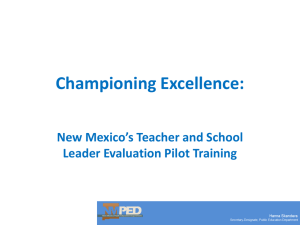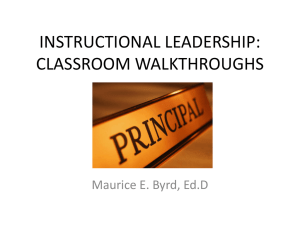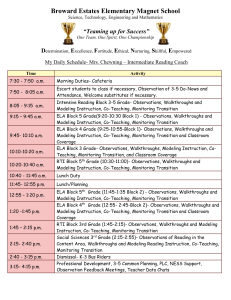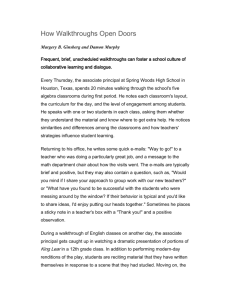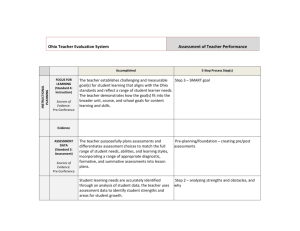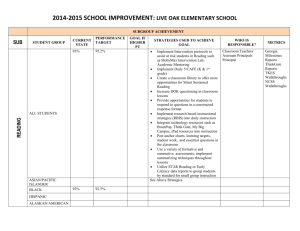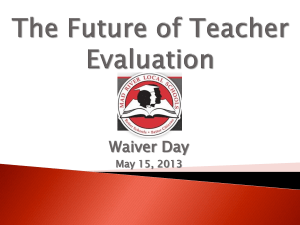Engaging Teachers in Classroom Walkthroughs.
advertisement
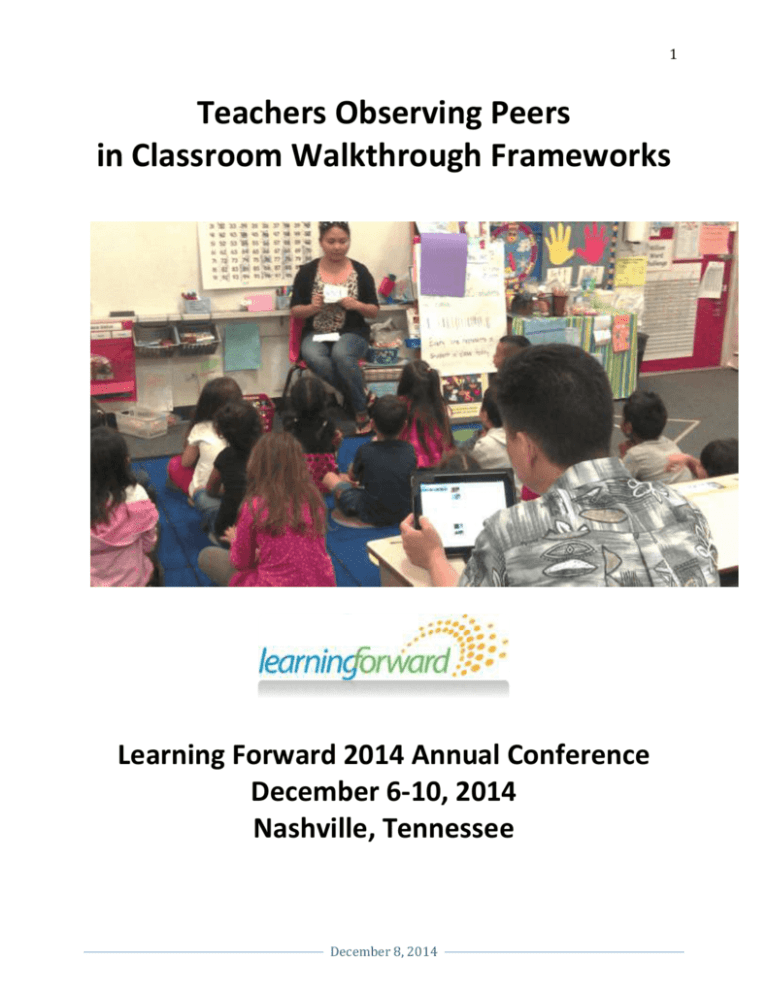
1 Teachers Observing Peers in Classroom Walkthrough Frameworks Learning Forward 2014 Annual Conference December 6-10, 2014 Nashville, Tennessee December 8, 2014 2 Presenters Donald S. Kachur is Professor Emeritus of Education from the Department of Curriculum and Instruction in the College of Education at Illinois State University, Normal, Illinois. He holds a doctorate in education from Indiana University in Bloomington. He served from 2001 to 2008 as the full-time Executive Director of the Illinois affiliate of ASCD. Don is a workshop trainer for the Illinois Administrators Academy, the Illinois Principals Association, and the Illinois Association of School Administrators. In the business realm, he served as an executive consultant at State Farm Corporate and participated in the delivery of State Farm Advanced Management Seminars. In addition, Don served as a certified trainer with Motorola, Inc. for their Leadership Development Institutes for school superintendents and Executive Leadership Institutes for school principals. He coauthored the books Classroom Walkthroughs to Improve Teaching and Learning (2010) published by Routledge/Eye on Education and Engaging Teachers in Classroom Walkthroughs (2013) published by ASCD. He has also published in the NASSP Bulletin, Phi Delta Kappan, Kappa Delta Pi Record, Journal of Teacher Education, Journal of Staff Development, Florida Educational Leadership, and The Clearing House. He is an active member of ASCD and served on its board of directors from 2007 to 2010. He can be reached at dskachu@ilstu.edu. Claudia L. Edwards is the graduate coordinator for the School of Education and Behavioral Sciences at Cameron University in Lawton, Oklahoma. She earned her B.S. and M.Ed. at Cameron University. She is a retired classroom teacher with 29 years of teaching experience in the Oklahoma public school system. Her teaching experience ranges from kindergarten through college. As a secondary teacher, Claudia developed a transition program for middle school entry-level students. She also helped create a Saturday program for at-risk students and was the district co-trainer for cooperative learning. During her teaching career, she served as a supervising teacher to interns, was a staff developer, and was an assessor for the National Board for Professional Teaching Standards (NBPTS). She coauthored the books Classroom Walkthroughs to Improve Teaching and Learning (2010) published by Routledge/Eye on Education and Engaging Teachers in Classroom Walkthroughs (2013) published by ASCD. She also coauthored articles for Educational Leadership, Florida Educational Leadership, and the Oklahoma Middle Level Education Association Journal and has presented at numerous professional conferences. She can be reached at cedwards@cameron.edu. December 8, 2014 3 Session Objectives 1. Overcoming Resistance to Peer Observations 2. Models of Classroom Walkthroughs 3. Issues to Consider in Designing Classroom Walkthroughs ____________________________________ Kachur, Donald, S., Stout, Judith A., & Edwards, Claudia L. (2010) Classroom Walkthroughs to Improve Teaching and Learning. Routledge/Eye on Education (Examines eighteen walkthrough models from across the country for the purpose of designing a model that fits one’s own school setting.) ____________________________________ Kachur, Donald, S., Stout, Judith A., & Edwards, Claudia L. (2013) Engaging Teachers in Classroom Walkthroughs. Alexandria, VA: ASCD. (Reports findings and recommendations in the authors’ study of 40 schools from 30 school districts in seventeen states and Canada that have actively involved teachers in the design and participation as observers in walkthroughs.) ____________________________________ Features of Peer Observations 1. Breaks down ISOLATIONISM. According to Richard Elmore (2007), “Privacy of Practice produces isolation, and isolation very well serves as the enemy of improvement.” 2. Teachers need to be the EXPERTS in their own school. 3. The farther from the source of classroom data people are (for example, district-level staff observing in the classroom, or even the principal, versus teachers observing one another through walkthroughs), the less impact they will have on changing classroom teaching behavior. December 8, 2014 4 4. Peer Observations represent “job-embedded professional development.” Morrison, N. (02/05/2014) What we can learn from the success of Shanghai’s schools. Go to http://www.forbes.com/sites/nickmorrison/2014/02/05/what-wecan-learn-from-the-success-of-shanghais-schools/. Tatter, G. (10/6/2014) Tennessee Principals Embrace Teaching Collaboration Model from Shanghai. (October 6, 2014). Chalkbeat Tennessee http://tn.chalkbeat.org/2014/10/06/tennessee-principals-embrace-teachingcollaboration-model-from-shanghai/ 5. Walkthroughs help with the creation of a “community of learning.” SESSION OBJECTIVE 1 OVERCOMING RESISTANCE TO PEER OBSERVATIONS Grounding Teachers in an Understanding of Walkthroughs (e.g., Book Study). Concerns with Peer Observations December 8, 2014 5 Concerns about the Walkthrough Process Concerns about Observations by Peers Concerns about the Actual Classroom Observations Concerns about Follow-up December 8, 2014 6 Trust and Safety Trust in a walkthrough initiative will be helped by (1) assuring staff that the process is non-evaluative; (2) sharing leadership with teachers so they have a voice in the design or selection, implementation, and evaluation of the walkthrough process; (3) supporting teachers with training, resources, and time to work and learn together; and (4) ensuring that communication with and among teachers about the purposes, intentions, and protocols of the walkthroughs is transparent. Develop Walkthrough Norms Norms for Teachers Observing During Norms for Teachers in Follow-up Walkthroughs Conversations and Thereafter December 8, 2014 7 Begin with Volunteers Build Advocacy (Teacher Leaders/School Leadership Team) Organization Dynamics % 10 20 40 20 10 December 8, 2014 8 Accompany Teachers Doing Walkthroughs Focus Observations on Student Learning Rather than Instruction Provide Forums for Observing Teachers to Share Their Experiences December 8, 2014 9 Walkthroughs Without Students (Ghost Walks) Start Slowly and Keep Process Simple December 8, 2014 10 SESSION OBJECTIVE 2 MODELS OF CLASSROOM WALKTHROUGHS Instructional Rounds is a label used for a model that represents a practice for small groups of classroom teachers to make brief observations in other classrooms. This model allows observing teachers to compare their own instructional practices with those of the teachers they watch. Upon completion of the rounds, the observing teachers engage in a facilitated discussion reflecting on what they noticed. Instructional rounds end when participants identify instructional practices for their own use because they saw other teachers using them effectively. They will reexamine their own instructional strategies and evaluate their effectiveness. Marzano, Robert J., Frontier, Tony, & Livingston, David. (2011). Effective Supervision: Supporting the Art and Science of Teaching. Alexandria, VA: ASCD. (This reference includes information on Instructional Rounds.) Marzano, Robert J. Making the Most of Instructional Rounds. Educational Leadership. Vol. 68, No. 5. February 2011, pages 80-81. (This journal article is all about Instructional Rounds.) Teacher Driven Observations (TDO) allows each classroom teacher to be fully in charge of his or her professional learning. In other words, the primary learning value is for the observed teacher who takes charge by moving PD into his or her classroom. Other teachers are invited to come into the classroom to observe and collect classroom data that the requesting teacher jointly analyzes with observers to inform and improve his or her instruction and students’ learning. In this model, the observation is flanked by a pre-observation meeting and postobservation debriefing. In the pre-observation meeting, the observed teacher shares the purpose and focus of the observation and describes the context for the lesson and the logistics (when the observation will occur and what data will be collected) with the observers. The observation occurs, and though it can last the entire class period, TDO recommends 15-20 minutes are usually sufficient to acquire enough data about the area of focus. The final stage is the post-observation debriefing which, like the pre-observation meeting, is guided by the use of a protocol. In this stage, the observed teacher and observers will analyze the data together. They share the data of what they observed and collectively discuss implications for instruction and commit to the next steps Kaufman, T. E., & Grimm, E. D. (2013). The Transparent Teacher: Taking Charge of Your Instruction with Peer-Collected Classroom Data. San Francisco, CA: John Wiley & Sons. (The authors introduce a model that involves classroom teachers inviting others into their classrooms to observe and provide feedback on a pre-identified area of focus for teaching improvement.) December 8, 2014 11 Teacher Rounds is a model similar in many ways to the Teacher-Driven Observation. A teacher round is led by a teacher in her or his classroom; it is conducted mainly by, for, and with teachers as a reflective, inquiring, and collaborative learning process. A teacher round is always framed by the round teacher—the teacher who prepares and hosts the round in her or his classroom. A teacher round involves a minimum of three and up to seven teachers (including the round teacher). Like the TDO, there is a pre-round discussion, the round observation, and post-round discussion guided by some protocol for conversation. Del Prete, T. (2013). Teacher Rounds: A Guide to Collaborative Learning in and From Practice. Thousand Oaks, CA: Corwin Press. (This book provides the theory and background of teacher rounds as one of the best ways to get teachers out of their classrooms and into each other’s classrooms for their own learning and for school improvement.) Troen, V., Boles, K.C., Pinnolis, J, & Scheur, A. (2014). The Power of Teacher Rounds: A Guide for Facilitators, Principals, and Department Chairs. Thousand Oaks, CA: Corwin Press. (With teacher rounds, educators benefit from the observant peer learning that’s common in other demanding fields. From practical strategies to ready-to-use templates, this book offers a complete toolkit for leading a thriving teacher rounds program.) Teaching Squares is a model that offers the teachers the opportunity to improve their own teaching by observing their square partners in an actual classroom situation. A teaching square consists of a group of four teachers from the same or different disciplines visiting one another, either reciprocally or in rotation. In teaching squares, participants in the square learn about the best practices of their peers in teaching to the CCSS in order to improve their own teaching. Here teachers will commit approximately 6-8 hours over a 6- to 8-week period. Observing an entire class session is best, but shorter informal visits, or walkthroughs, are also helpful. In this model, each participant will observe each partner for at least one period of classroom teaching and share course materials with observers. The square partners reflect on their observation experiences and share those reflections with each other. Do a search on any internet browser entering the key words “Teaching Squares.” UCLA Center X Classroom Walk-Throughs is a protocol used for teachers to observe students at work and then debrief their observations in order to identify patterns of successful learning. This non-evaluative protocol generates useful data about student learning and ties it to effective instructional practices through professional inquiry based on educators’ questions about student learning. Training is necessary for observers to learn and practice a protocol for observing students as they work. They learn to design effective focus questions for classroom observations and how to be objective in recording observations. During post-observation conversations, participants identify patterns of practice that result in high levels of student learning, and they identify trends in student data that suggest areas for professional inquiry. The art of questioning is practiced to build trust, provide new perspectives, and establish priorities for focused, collaborative action across multiple school initiatives. December 8, 2014 12 Martinez-Miller, Patricia, & Cervone, Laureen. (2008). Breaking Through to Effective Teaching: A Walk-Through Protocol Linking Student Practice and Professional Practice. Lanham, MD: Rowman & Littlefield Education. (This book serves as a good reference on the UCLA Center X Classroom Walkthrough model that heavily involves teachers as the walkthrough observers.) Instructional Talk-Throughs (ITT) is a model designed to help teachers move toward effective teacher practice, curricular content, student engagement, and assessment practices that enhance student success. This model occurs in the K-9 Edmonton Public Schools (Alberta, Canada) where teachers from six different schools participate in this on-going classroomembedded professional development known as Instructional Talk-Throughs. ITT involves each school hosting teacher teams from other schools. The teacher teams visit a selected number of classrooms for 15-20 minutes each. Unique to this process is that observed teachers invite and share in advance what visiting teachers will see. They also request feedback from the visiting teachers on those observations. Teachers are trained to facilitate the ITT process in order to help with the post-observation discussions between hosting teachers and visiting teacher teams. Cronk, Dorothy, Inglis, Linda, Michailides, Dean, Michailides, Mary, Morris, David, and Peterssen, Nancy. (2008). Walking the Talk: Instructional Talk-Throughs. The ATA News 43 (3), 1-3. (This model is a great example of teacher involvement in walkthroughs and cooperation among schools for the process.) Go to http://www.educationworld.com/a_admin/admin/admin494.shtml Data-in-a-Day provides a structure for teams of classroom visitors to observe teaching and learning throughout a school in a single day. It was first introduced at the Northwest Regional Educational Laboratory as a way to involve students in school improvement. Data-in-a-Day uses four focus questions from the Motivation Framework for Culturally Responsive Teaching to help educators get a practical view of what teaching and learning looks like in their school. Teams of visitors are sent on a selected day into the school’s classrooms to take “snapshots” of the teaching and learning occurring. The teams of visitors may consist of teachers, parents, community members, students, and possibly other participants. Generally, some training is provided to introduce observers to looking at instructional practices that engage learners. Then teams work together to summarize and chart the observation data and present the findings to the school. Go to http://www.aimcenterseattle.org/motivation/diad. December 8, 2014 13 SESSION OBJECTIVE 3 ISSUES TO CONSIDER IN DESIGNING CLASSROOM WALKTHROUGHS The Role of the Principal First and foremost, it is the paramount role of the school principal that was strongly reinforced by all of the schools we studied where teacher walkthroughs thrived. Arranging Schedule and Time for Teachers to Observe 1. Have rotating substitute teachers to cover classes of observing teachers; 2. Use the principal, assistant principal, instructional coaches, mentors, or aides to cover classes of those teachers participating in walks; 3. Combine classes (with teacher agreement) so teachers can be released for walkthroughs; 4. Seek approval to use department, subject, or grade-level common planning time for debriefings; 5. Use individual teacher planning time when no other options are available and if teachers agree; 6. Use school staff meetings to share observations and conduct reflective conversations; 7. Use late start or early release staff development days for post-walkthrough discussions; and/or 8. Modify the modular schedule to open times. December 8, 2014 14 Coordinating the Walkthrough Process The coordination responsibilities include one or more of the following: Provide or arrange for training of teachers in walkthroughs (covering such things as protocols, observation, professional conversations); Prepare and communicate the visitation schedule of teachers who will be observing; Communicate with teachers to be observed to ensure clarity of the protocol; Help facilitate the creation of the focus questions and identification of the look-fors; Establish roles and responsibilities of observing team members; Provide training on the software program used for observations; Arrange for release time when teachers are walking; Participate in observations; Prepare and oversee the sharing of observation data; Arrange for time and location for follow-up and sharing and debriefing of observation data; Develop the agenda for the classroom walkthrough team meeting; Assist with the development and monitoring of follow-up actions; Acquire funding to support the process; Listen to and address staff concerns about the walks; Assist with the evaluation of the walkthrough process. Prepare Teachers for Peer Observations December 8, 2014 15 Avoid Judgmental/Evaluative Recordings/Conversations Consider Using Protocols to Conversations A protocol specifies a structure for the conversation that defines the steps to follow in the conversation, the roles of participants, and time frame for each step of the conversation. Allen, D., & Blythe, T. (2004). The Facilitator’s Book of Questions: Tools for Looking Together at Student and Teacher Work. Teachers College Press and the National Staff Development Council. Easton, L. B. (2009). Protocols for Professional Learning. Alexandria, VA: ASCD. Glaude, C. (2011). Protocols for Professional Learning Conversations: Cultivating the Art and Discipline. Joint publication of Solution Tree and Connections Publishing. McDonald, J. P., Mohr, N., Dichter, A., & McDonald, E.C. (2013). The Power of Protocols: An Educator’s Guide to Better Practice. New York, NY: Teachers College Press. NEXT STEPS Actions Resulting from Observations and Reflective Discussions December 8, 2014 16 NEXT STEPS (Action Plan Template*) Beginning (date?) ___________________________, the following teachers/staff __________________________________________________________________ will (do what?) __________________________________________________________________ __________________________________________________________________ (how often?) __________________________________________________________________ __________________________________________________________________ with (Form? Statement? Report?) __________________________________________________________________ __________________________________________________________________ being submitted to (whom?) _________________ as a measure of commitment. *David Shepard, lead consultant for The Middle Matters. Connect Peer Observations to Other School Improvement Efforts Evaluate the Classroom Walkthrough Process Reflective Thoughts! What is one thing you are going to do as a result of attending today’s session? December 8, 2014 17 Other Thoughts about This Session!! What are the possibilities I see for using the information I learned today? What did we discuss today that leaves me with some questions and what are those questions? With whom and how will I share this information back in my school district? (Who besides me can learn from what I learned today?) What are three key ideas I learned today that I want to share with my colleagues? What are the resources I want to share with others related to what I learned today? December 8, 2014
